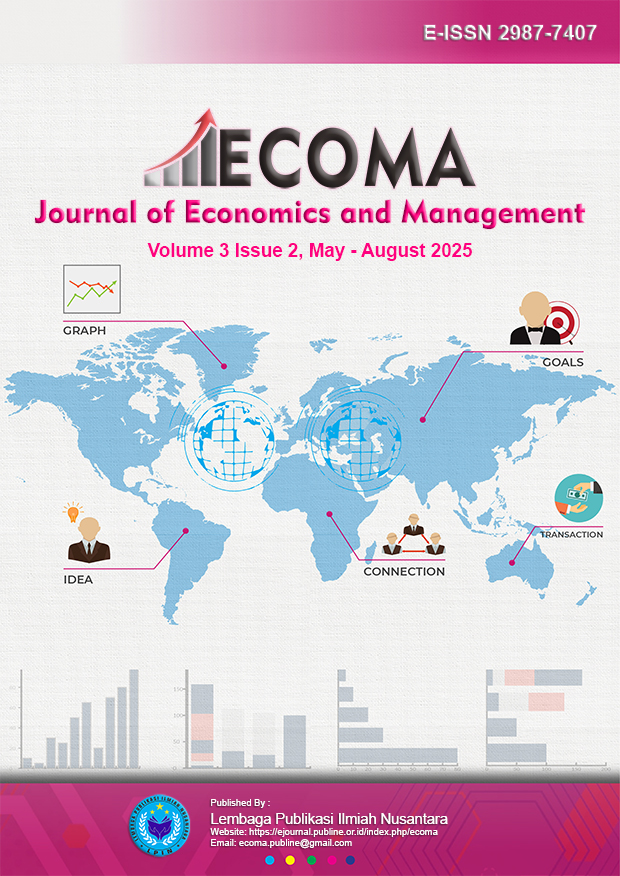Financial Behavior and Risk Tolerance as Determinants of Investment Decision Making among Young Adults in Urban Areas
DOI:
https://doi.org/10.70716/ecoma.v3i2.249Keywords:
financial behavior, risk tolerance, investment decisions, young adults, SEM–PLS, urban IndonesiaAbstract
This study investigates the relationship between financial behavior, risk tolerance, and investment decision-making among young adults in urban Indonesia. Using a quantitative approach, primary data were collected from 250 respondents aged 20–35 years residing in five major urban centers through an online survey. The study employs Structural Equation Modeling–Partial Least Squares (SEM–PLS) to analyze the interrelationships among financial literacy, budgeting habits, saving behavior, risk tolerance, and investment decision quality. The findings reveal that financial behavior significantly affects investment decision-making, both directly and indirectly through the mediating effect of risk tolerance. Respondents with disciplined saving and budgeting habits exhibit higher risk tolerance and tend to make more rational and goal-oriented investment choices. The study highlights the need for targeted financial education programs that address behavioral factors and risk profiling in order to improve the quality of investment decisions among urban youth.
Downloads
References
Alkan, Ö., Oktay, E., Ünver, Ş., & Gerni, E. (2020). Determination of factors affecting the financial literacy of university students in Eastern Anatolia using ordered regression models. Asian Economic and Financial Review, 10(5), 536–546. https://doi.org/10.18488/journal.aefr.2020.105.536.546
Amri, A., Ramdani, Z., Warsihna, J., & Tae, L. F. (2022). The development and validation of a financial management behavior (FMB) scale in postgraduate students. Jurnal Manajemen Indonesia, 22(2), 189–198. https://doi.org/10.25124/jmi.v22i2.4006
Aman, H., Motonishi, T., Ogawa, K., & Omori, K. (2024). The effect of financial literacy on long-term recognition and short-term trade in mutual funds: Evidence from Japan. International Review of Economics & Finance, 89, 762–783. https://doi.org/10.1016/j.iref.2023.10.006
Atkinson, A., & Messy, F.-A. (2012). Measuring financial literacy: Results of the OECD / International Network on Financial Education (INFE) pilot study. OECD Working Papers on Finance, Insurance and Private Pensions, 15. https://doi.org/10.1787/5k9csfs90fr4-en
Bodie, Z., Kane, A., & Marcus, A. J. (2014). Investments (10th ed.). McGraw-Hill Education.
de Bassa Scheresberg, C. (2013). Financial literacy and financial behavior among young adults: Evidence and implications. Numeracy, 6(2), Article 5. https://doi.org/10.5038/1936-4660.6.2.5
Ergün, K. (2018). Financial literacy among university students: A study in eight European countries. International Journal of Consumer Studies, 42(1), 2–15. https://doi.org/10.1111/ijcs.12408
Falahati, L., Sabri, M. F., & Paim, L. H. (2012). Assessment of university students’ financial management skills and educational needs. African Journal of Business Management, 6(12), 4460–4464. https://doi.org/10.5897/AJBM11.1522
Fonseca, R., Mullen, K. J., Zamarro, G., & Zissimopoulos, J. (2012). What explains the gender gap in financial literacy? The role of household decision making. Journal of Consumer Affairs, 46(1), 90–106. https://doi.org/10.1111/j.1745-6606.2011.01221.x
Grable, J. E., & Joo, S. H. (2004). Environmental and biophysical factors associated with financial risk tolerance. Journal of Financial Counseling and Planning, 15(1), 73–82.
Grable, J. E., & Lytton, R. H. (1999). Financial risk tolerance revisited: The development of a risk assessment instrument. Financial Services Review, 8(3), 163–181. https://doi.org/10.1016/S1057-0810(99)00041-4
Hoffmann, A. O. I., Post, T., & Pennings, J. M. E. (2013). Individual investor perceptions and behavior during the financial crisis. Journal of Banking & Finance, 37(1), 60–74. https://doi.org/10.1016/j.jbankfin.2012.08.007
Joo, S.-H., & Grable, J. E. (2004). An exploratory framework of the determinants of financial satisfaction. Journal of Family and Economic Issues, 25, 25–50. https://doi.org/10.1023/B:JEEI.0000016722.37994.9f
Lusardi, A., & Mitchell, O. S. (2014). The economic importance of financial literacy: Theory and evidence. Journal of Economic Literature, 52(1), 5–44. https://doi.org/10.1257/jel.52.1.5
Mahat, N. A. B., & Lau, W.-T. (2023). Financial literacy, investment experience, risk tolerance and investment behavior: Observations during pandemic. International Journal of Research and Innovation in Social Science (IJRISS), 7(1), 558–573. https://doi.org/10.47772/IJRISS.2023.701046
Mouna, A., & Anis, J. (2017). Financial literacy in Tunisia: Its determinants and implications on investment behavior. Research in International Business and Finance, 39, 568–577. https://doi.org/10.1016/j.ribaf.2016.09.018
OJK (Otoritas Jasa Keuangan). (2023). Laporan Statistik Pasar Modal Indonesia 2023. Jakarta: OJK.
Phuong Dang, L., Nguyen, L. N., & Tran, K. (2017). Are Vietnamese individual investors financially literate? A preliminary study. Journal of Economics, Business and Management, 5(5), 205–212. https://doi.org/10.18178/JOEBM.2017.5.5.513
Perry, V. G., & Morris, M. D. (2005). Who is in control? The role of self-perception, knowledge, and income in explaining consumer financial behavior. Journal of Consumer Affairs, 39(2), 299–313. https://doi.org/10.1111/j.1745-6606.2005.00016.x
Pompian, M. M. (2006). Behavioral finance and wealth management: How to build optimal portfolios that account for investor biases. John Wiley & Sons.
Saputra, F. (2024). Financial management behavior of millennials. International Journal of Business, Law, and Education, 5(1), 1153–1161. https://doi.org/10.56442/ijble.v5i1.532
Shefrin, H., & Thaler, R. H. (1988). The behavioral life-cycle hypothesis. Economic Inquiry, 26(4), 609–643. https://doi.org/10.1111/j.1465-7295.1988.tb01520.x
Van Rooij, M., Lusardi, A., & Alessie, R. (2011). Financial literacy and stock market participation. Journal of Financial Economics, 101(2), 449–472. https://doi.org/10.1016/j.jfineco.2011.03.006
Widdowson, D., & Hailwood, K. (2007). Financial literacy and its role in promoting a sound financial system. Reserve Bank of New Zealand Bulletin, 70(2), 37–47.
Xiao, J. J., & Porto, N. (2017). Financial education and financial satisfaction: Financial literacy, behavior, and capability as mediators. International Journal of Bank Marketing, 35(5), 805–817. https://doi.org/10.1108/IJBM-01-2016-0009
Zahera, S. A., & Bansal, R. (2018). Do investors exhibit behavioral biases in investment decision making? A systematic review. Qualitative Research in Financial Markets, 10(2), 210–251. https://doi.org/10.1108/QRFM-04-2017-0028
Downloads
Published
How to Cite
Issue
Section
License
Copyright (c) 2025 Ahmad Rizky, Lestari Wulandari, Nurul Azizah, Fiona Walsh

This work is licensed under a Creative Commons Attribution-ShareAlike 4.0 International License.











